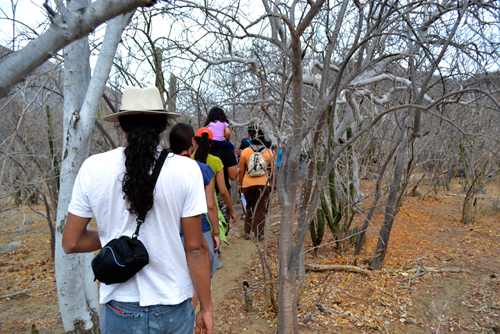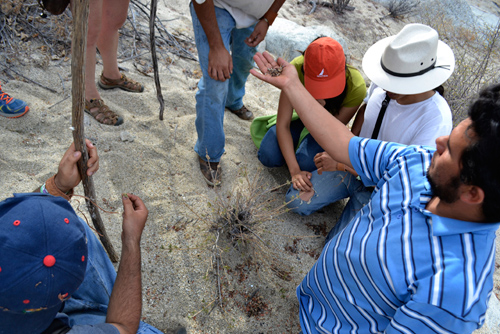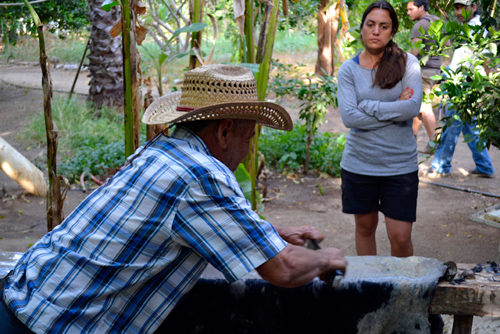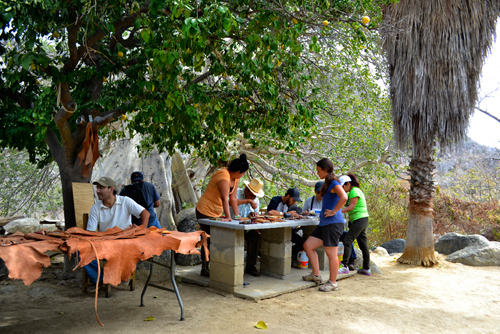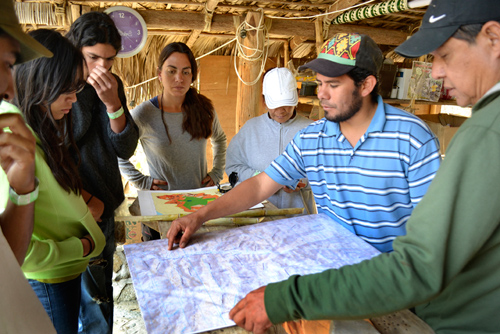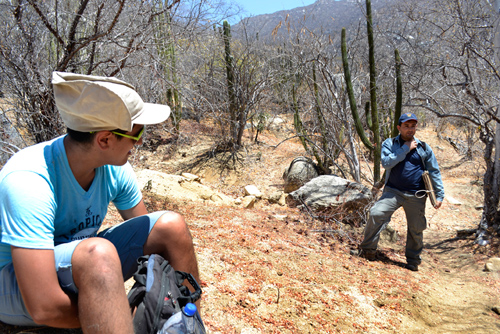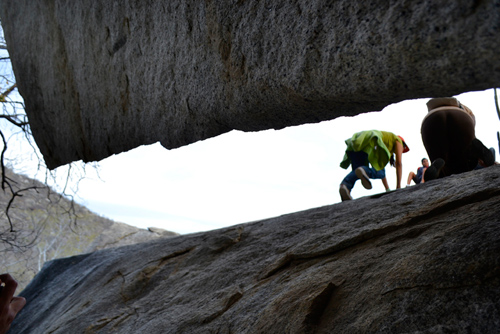Rural Interaction |
Rural Interaction and Transdisciplinary Art Production Project with Ranchers from SudCalifornia | |
Proyecto Interaccion Rural y Produccion Artistica Transdisciplinar en la Rancheria SudCaliforniana. Apoyado por el Fondo Nacional para la Cultura y Las Artes / Programa de Fomento a Proyectos y Coinversiones Culturales -2013 La dinámica del viaje, lleno de actividades y trayectos de creación de sentido, me llevó a una experiencia introspectiva donde la naturaleza y sus patrones de organización hallaban eco en el cuerpo y sus estructuras íntimas, invisibles bajo la piel pero muy presentes ante el esfuerzo físico y la apertura de los sentidos. El paisaje entra por los ojos y pulmones, los retorcidos troncos y raíces nos recuerdan estructuras óseas, venas y neuronas pulsantes. El trabajo colectivo resuena como un solo organismo transformador. La voluntad individual cede ante un objetivo común. Me impactó la capacidad de modelar el paisaje agreste y desértico en un vergel tropical paradisiaco. Bajo los árboles frutales la agradable temperatura me hacía olvidar las condiciones extremas del clima. El conocimiento desarrollado por generaciones para el aprovechamiento de los recursos era patente en los ranchos visitados, desde los niveles básicos de tratamiento de agua hasta y producción de alimentos hasta la transformación de materias primas en objetos funcionales y herramientas no exentas de un valor estético. El tiempo vuelve a su cauce de ciclos y ritmos orgánicos, la luz, las lluvias, las aves y sus cantos. Para nosotros los urbanos, perseguidos por el vértigo del “progreso” cuyas urgencias han consumido el tiempo de la contemplación, las pausas para meditar el peso de los eventos y para la distensión del cuerpo, representa una oportunidad para recordar el balance de la vida y el fundamento de lo vivo. Ese contraste de ritmos se hace patente en las pugnas actuales por transfundir el desarrollo a la región e imponer los índices de crecimiento que el mercado global impone, poniendo en peligro todo aquello que es considerado atraso, todo aquello que detiene y retrasa el desarrollo. La preponderancia de la cantidad sobre la calidad de vida, esa obsesión por la multiplicación de los panes que ni siquiera contempla la repartición equitativa de los mismos, díganse los frutos y riquezas del desarrollo que solo sirven para engrosar las gordas carteras de los inversionistas y producir más consumidores enajenados y eternamente insatisfechos. |
This project aims to assist in the preservation and promotion not only of the cultural aspect of life in SanDioniso but also the preservation of the land through the promotion of responsible eco-cultural-tourist activities.
The dynamics of the journey, full of activities and routes creation of meaning, took me to an introspective experience where nature and patterns of organization were echoed in the body and its intimate, invisible under the skin but very present structures to physical effort and the opening of the senses. The landscape comes through the eyes and lungs, twisted trunks and roots remind us bony structures, veins pulsing neurons. The collective work resonates as a single transformer body. The individual will yield to a common goal. I was struck by the ability to model the rugged desert landscape into a heavenly tropical orchard. Under the fruit trees the cool temperatures made me forget the extreme weather conditions. The knowledge developed over generations for the use of resources was evident in the visited farms, from the basic levels of water treatment and food production up to the transformation of raw materials into functional objects and not without aesthetic value tools. Weather back to normal cycles and organic rhythms, light rain, birds and their songs. For us urban, pursued by the vertigo of "progress" whose emergency consumed time of contemplation, pauses to ponder the weight of events and for the relaxation of the body, is an opportunity to remember the balance of life and the foundation of the living. That contrast of rhythms is evident in current struggles for transfusing development to the region and impose growth rates than the overall market places, endangering everything that is considered late, everything stops and delays development. The preponderance of quantity over quality of life, this obsession with the multiplication of the loaves that even includes the equitable distribution thereof, tell yourself the fruits of development and wealth that only serve to swell the fat wallets of investors and produce ever more alienated and dissatisfied consumers. |
|
Serie Fotográfica Estructura de Camino Gráfica Digital Bitácora Vegetal
Entrevistas llevadas a cabo durante la segunda edición del proyecto Interacción rural y producción artistica transdiciplinaria en las rancherias sudcalifornianas, llevado a cabo por Santiago M. Bringas, en San Dionisio, Baja California Sur. |
||
| + info Rural Interaction Blog |
||
